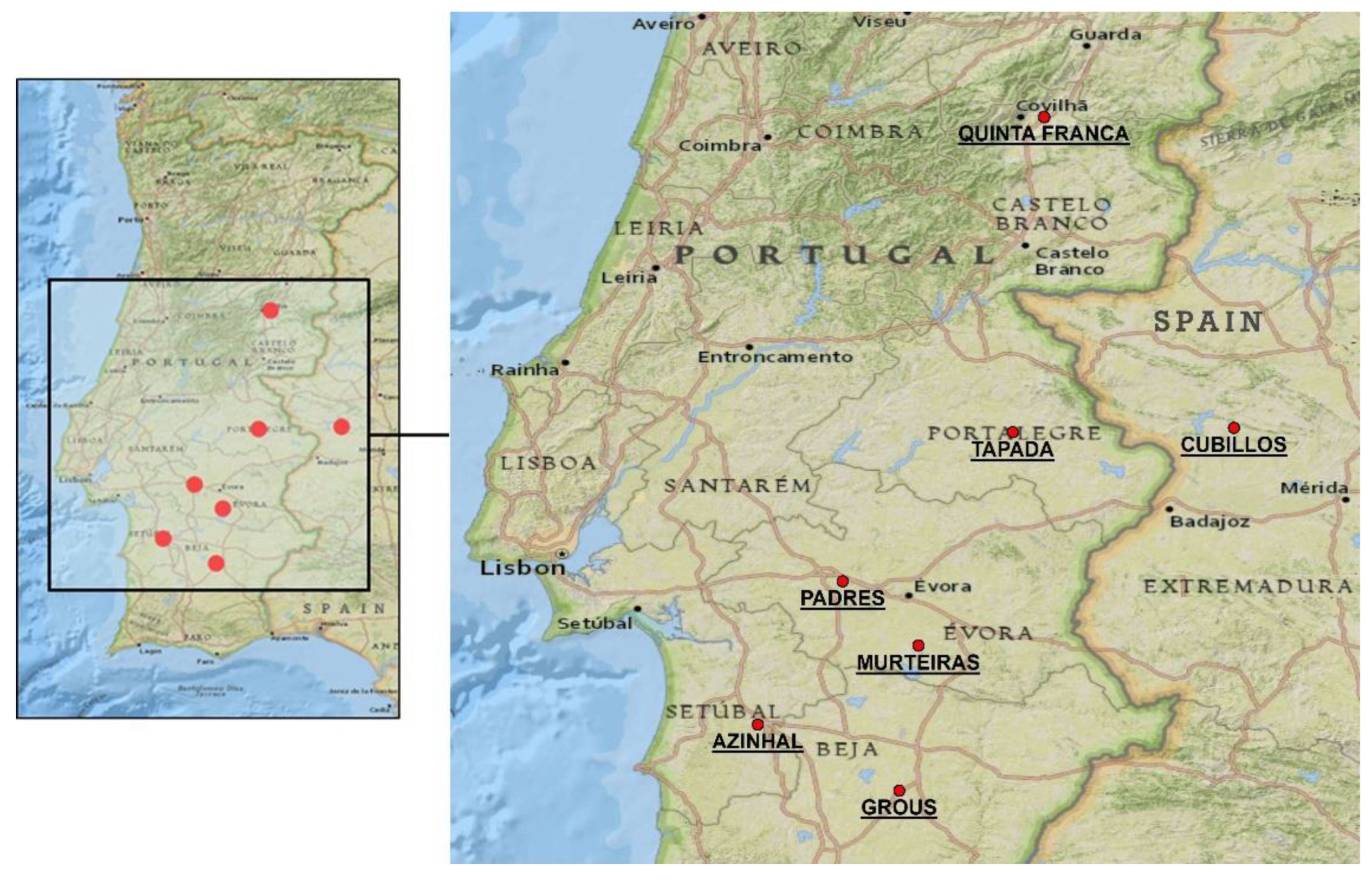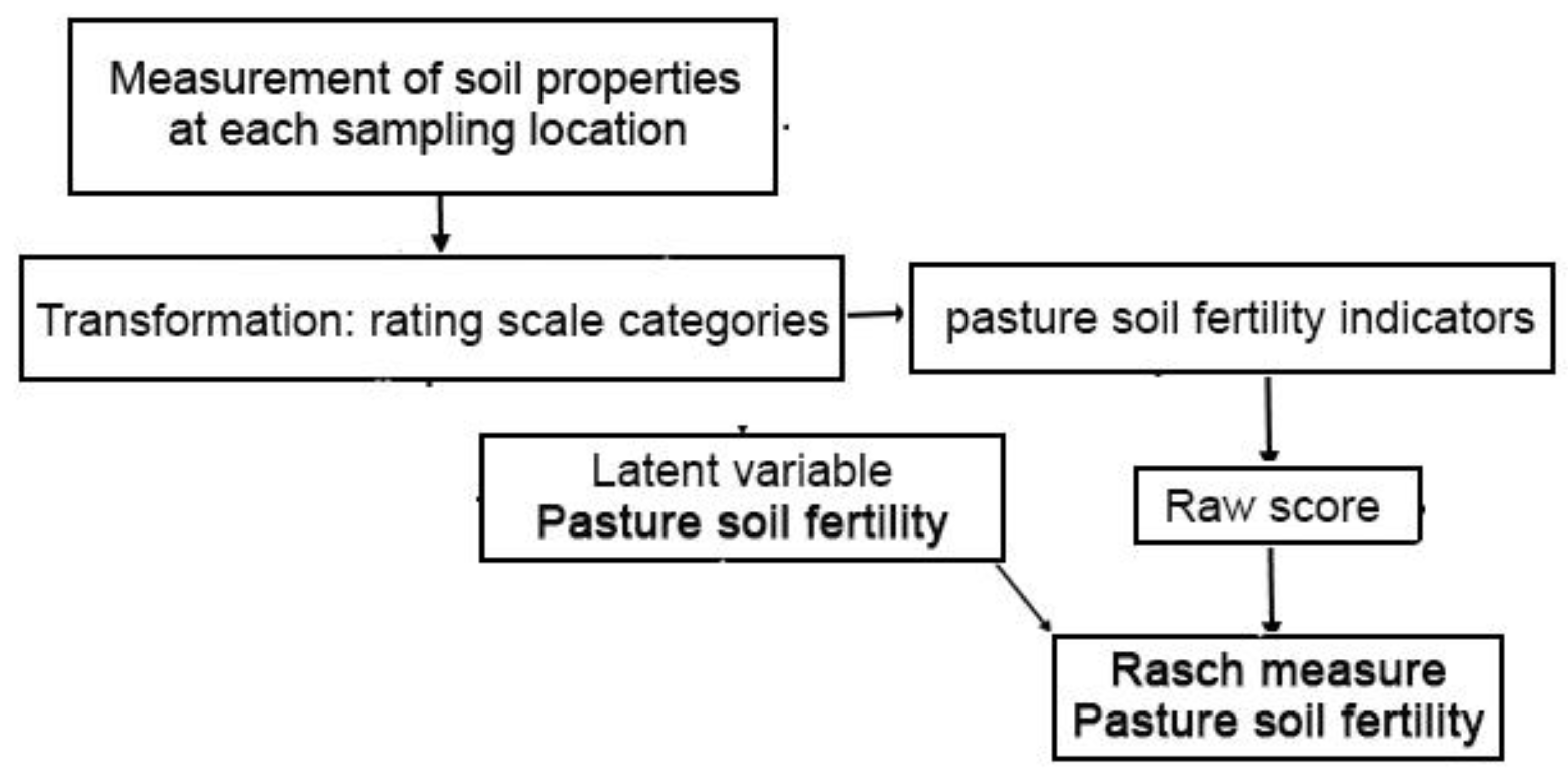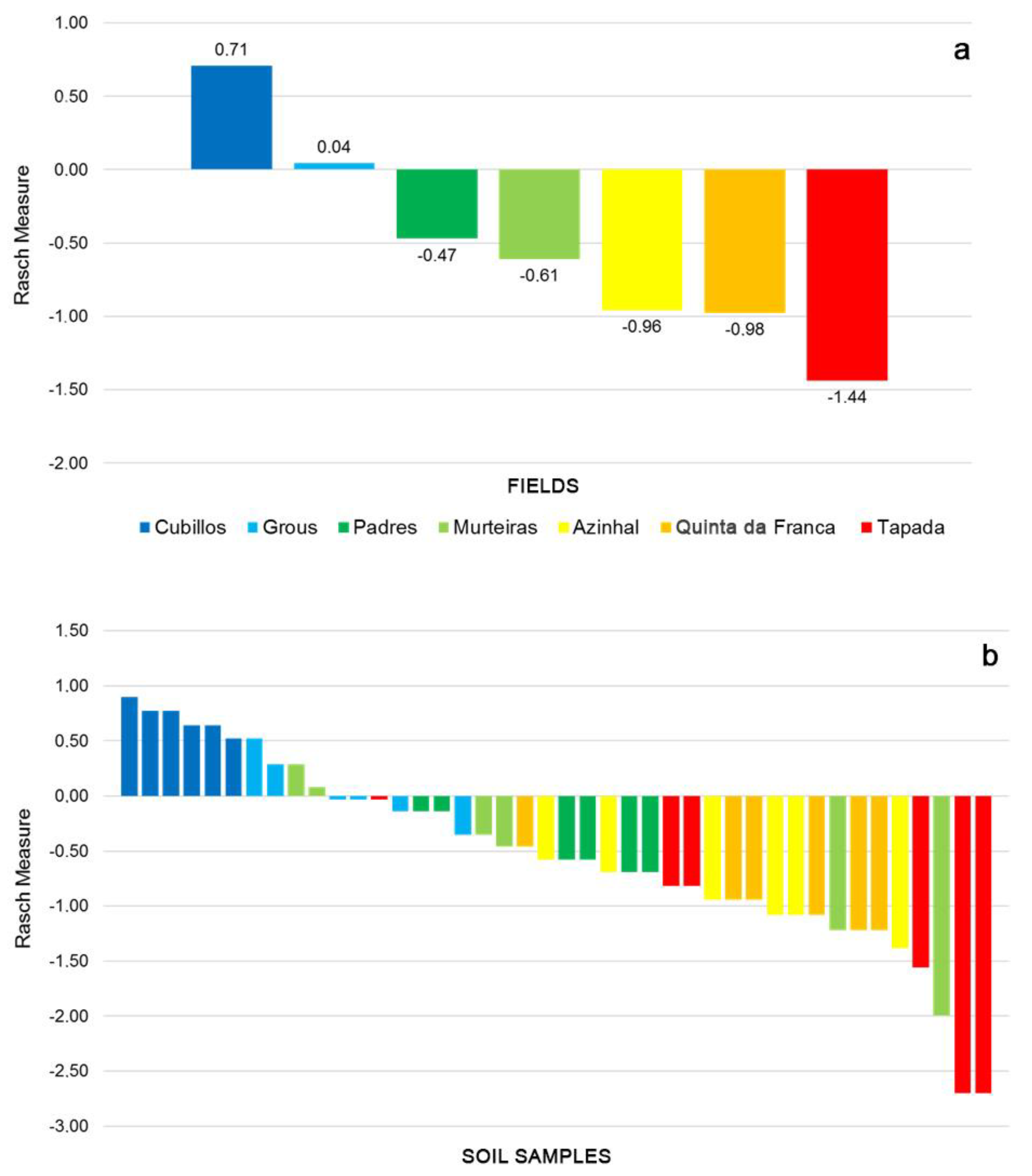Comparative Analysis of Pasture Soil Fertility in Semiarid Agro-Silvo-Pastoral Systems
Abstract
1. Introduction
2. Materials and Methods
2.1. Experimental Fields
2.2. Soil Sample Collection and Analysis
2.3. The Rasch Model
3. Results and Discussion
4. Conclusions
Author Contributions
Funding
Data Availability Statement
Conflicts of Interest
References
- David, T.S.; Henriques, M.O.; Kurz-Besson, C.; Nunes, J.; Valente, F.; Vaz, M.; Pereira, J.S.; Siegwolf, R.; Chaves, M.M.; Gazarini, L.C.; et al. Water-use strategies in two co-occurring Mediterranean evergreen oaks: Surviving the summer drought. Tree Physiol. 2007, 27, 793–803. [Google Scholar] [CrossRef] [PubMed]
- Nawar, S.; Corstanje, R.; Halcro, G.; Mulla, D.; Mouaze, A.M. Chapter dour-delineation of soil management zones for variable-rate fertilization: A review. Adv. Agron. 2017, 143, 175–245. [Google Scholar]
- Moral, F.J.; Rebollo, F.J.; Serrano, J.M. Delineating site-specifc management zones on pasture soil using a probabilistic and objective model and geostatistical techniques. Precis. Agric. 2020, 21, 620–636. [Google Scholar] [CrossRef]
- Serrano, J.; Shahidian, S.; Marques da Silva, J.; Paixao, L.; Calado, J.; de Carvalho, M. Integration of soil electrical conductivity and indices obtained through satellite imagery for differential management of pasture fertilization. AgriEngineering 2019, 1, 567–585. [Google Scholar] [CrossRef]
- Moral, F.J.; Rebollo, F.J.; Serrano, J.M.; Carvajal, F. Mapping management zones in a sandy pasture soil using an objective model and multivariate techniques. Precis. Agric. 2021, 21, 620–636. [Google Scholar] [CrossRef]
- Serrano, J.; Shahidian, S.; Marques da Silva, J.; Sales-Baptista, E.; Ferraz de Oliveira, I.; Lopes de Castro, J.; Pereira, A.; Cancela d’Abreu, M.; Machado, E.; Carvalho, M. Tree influence on soil and pasture: Contribution of proximal sensing to pasture productivity and quality estimation in montado ecosystems. Int. J. Remote Sens. 2018, 39, 4801–4829. [Google Scholar] [CrossRef]
- Schellberg, J.; Hill, M.J.; Roland, G.; Rothmund, M.; Braun, M. Precision agriculture on grassland: Applications, perspectives and constraints. Eur. J. Agron. 2008, 29, 59–71. [Google Scholar] [CrossRef]
- Diffenbaugh, N.S.; Giorgi, F. Climate Change Hotspots in the CMIP5 Global Climate Model Ensemble. Clim. Chang. 2012, 114, 813–822. [Google Scholar] [CrossRef]
- Peralta, N.R.; Costa, J.L.; Balzarin, M.; Franco, M.C.; Córdoba, M.; Bullock, D. Delineation of management zones to improvenitrogen management of wheat. Comput. Electron. Agric. 2015, 110, 103–113. [Google Scholar] [CrossRef]
- Moral, F.J.; Rebollo, F.J.; Serrano, J.M. Estimating and mapping pasture soil fertility in a portuguese montado based on a objective model and geostatistical techniques. Comput. Electron. Agric. 2019, 157, 500–508. [Google Scholar] [CrossRef]
- Moral, F.J.; Serrano, J.M. Using low-cost geophysical survey to map soil properties and delineate management zones on grazed permanent pastures. Precis. Agric. 2019, 20, 1000–1014. [Google Scholar] [CrossRef]
- Serrano, J.; Peça, J.; Marques da Silva, J.; Shahidian, S. Mapping soil and pasture variability with an electromagnetic induction sensor. Comput. Electron. Agric. 2010, 73, 7–16. [Google Scholar] [CrossRef]
- Stefanski, A.; Simpson, R.J. Uneven nurient distributionin hillside paddocks indicate potential need for variable rate fertiliser application to pastures. In Food Security from Sustainable Agriculture, Proceedings of the 15th Australian Agronomy Conference, Lincoln, New Zealand, 15–18 November 2010; Dove, H., Culvenor, R., Eds.; Australian Society of Agronomy/The Regional Institute Ltd.: Gosford, NSW, Australia, 2010. [Google Scholar]
- Serrano, J.; Shahidian, S.; Paixão, L.; Marques da Silva, J.; Moral, F. Management Zones in Pastures Based on Soil Apparent Electrical Conductivity and Altitude: NDVI, Soil and Biomass Sampling Validation. Agronomy 2022, 12, 778. [Google Scholar] [CrossRef]
- Shaddad, S.M.; Madrau, S.; Castrignanò, A.; Mouazen, A.M. Data fusion techniques for delineation of site-specific management zones in a field in UK. Precis. Agric. 2016, 17, 200–217. [Google Scholar] [CrossRef]
- Gavioli, A.; Souza, E.G.; Bazzi, C.L.; Guedes, L.P.C.; Schenatto, K. Optimization of management zone delineation by using spatial principal components. Comput. Electron. Agric. 2016, 127, 302–310. [Google Scholar] [CrossRef]
- Fortes, R.; Millán, S.; Prieto, M.H.; Campillo, C. A methodology based on apparent electrical conductivity and guided soil samples to improve irrigation zoning. Precis. Agric. 2015, 16, 441–454. [Google Scholar] [CrossRef]
- Trotter, M.; Guppy, C.; Haling, R.; Trotter, T.; Edwards, C.; Lamb, D. Spatial variability in pH and key soil nutrients: Is this an opportunity to increase fertiliser and lime-use efficiency in grazing systems? Crop Pasture Sci. 2014, 65, 817–827. [Google Scholar] [CrossRef]
- Xin-Zhong, W.; Guo-Shun, L.; Hong-Chao, H.; Zhen-Hai, W.; Qing-Hua, L.; Xu-Feng, L.; Wei-Hong, H.; Yan-Tao, L. Determination of management zones for a tobacco field based on soil fertility. Comput. Electron. Agric. 2009, 65, 168–175. [Google Scholar] [CrossRef]
- Ortega, R.A.; Santibáñez, O.A. Determination of management zones in corn (Zea mays L.) based on soil fertility. Comput. Electron. Agric. 2007, 58, 49–59. [Google Scholar] [CrossRef]
- Li, Y.; Shi, Z.; Li, F.; Li, H.Y. Delineation of site-specific management zones using fuzzy clustering analysis in a coastal saline land. Comput. Electron. Agric. 2007, 56, 174–186. [Google Scholar] [CrossRef]
- Morari, F.; Castrignanò, A.; Pagliarin, C. Application of multivariate geostatistics in delineating management zones within a gravelly vineyard using geo-electrical sensors. Comput. Electron. Agric. 2009, 68, 97–107. [Google Scholar] [CrossRef]
- Moral, F.J.; Terrón, J.M.; Rebollo, F.J. Site-specific management zones based on the Rasch model and geostatistical techniques. Comput. Electron. Agric. 2011, 75, 223–230. [Google Scholar] [CrossRef]
- Rebollo, F.J.; Moral, F.J.; Campillo, C.; Marques da Silva, J.R.; Serrano, J.M.; Pérez-Rodríguez, J.M. Delineation of management zones based on the Rasch model in an olive orchard. In Proceedings of the 11th European Conference on Precision Agriculture, Edinburgh, UK, 16–20 July 2017. [Google Scholar]
- Tristán, A. Análisis De Rasch Para Todos; Ceneval: Mexico City, Mexico, 2002. [Google Scholar]
- FAO. World reference base for soil resources. In World Soil Resources Reports N. 103; Food and Agriculture Organization of the United Nations: Rome, Italy, 2006. [Google Scholar]
- Peel, M.C.; Finlayson, B.L.; McMahon, T.A. Updated world map of the Köppen-Geiger climate classification. Hydrol. Earth Syst. Sci. 2007, 11, 1633–1644. [Google Scholar] [CrossRef]
- Egner, H.; Riehm, H.; Domingo, W.R. Utersuchungeniiber die chemische Bodenanalyse als Grudlagefir die Beurteilung des Nahrstof-zunstandes der Boden. II. K. Lantbr. Ann. 1960, 20, 199–216. [Google Scholar]
- Hambleton, R.K.; Swaminathan, H.; Rogers, H.J. Fundamentals of Item Response Theory; Sage Publishing: Newbury Park, CA, USA, 1991. [Google Scholar]
- Álvarez, P. Transforming non categorical data for Rasch analysis. In Rasch Measurement in Health Sciences; JAM Press: Maple Grove, MN, USA, 2004. [Google Scholar]
- Rasch, G. Probabilistic Models for Some Intelligence and Attainment Tests; Revised and expanded ed.; University of Chicago Press: Chicago, IL, USA, 1980. [Google Scholar]
- Ferrari, P.A.; Salini, S. Complementary use of Rasch Models and Nonlinear Principal Component Analysis in the Assessment of the Opinion of European About Utilities. J. Classif. 2011, 28, 53–69. [Google Scholar] [CrossRef]
- Bond, T.G.; Fox, C.M. Applying the Rasch Model: Fundamental Measurement in the Human Sciences; Lawrence Erlbaum Associates Inc.: Mahwah, NJ, USA, 2007. [Google Scholar]
- Edwards, A.; Alcock, L. Using Rasch analysis to identify uncharacteristic responses to undergraduate assessments. Teach. Math. Its Appl. Int. J. IMA 2010, 29, 165–175. [Google Scholar] [CrossRef][Green Version]
- Linacre, J.M. Winsteps (Computer Program and Manual); MESA Press: Chicago, IL, USA, 2009. [Google Scholar]
- Sekaran, U. Research Methods for Business: A Skill Building Approach; John Wiley & Sons Ltd.: New York, NY, USA, 2000. [Google Scholar]
- Bode, R.K.; Wright, B.D. Rasch measurement in higher education. In Higher Education: Handbook of Theory and Research; Smart, J.C., Tierney, W.G., Eds.; Agathon Press: New York, NY, USA, 1999. [Google Scholar]
- Moral, F.J.; Rebollo, F.J. Characterization of soil fertility using the Rasch model. J. Soil Sci. Plant Nutr. 2017, 17, 486–498. [Google Scholar] [CrossRef]
- Ceddia, M.B.; Vieira, S.R.; Villela, A.L.O.; Mota, L.S.; Anjos, L.H.C.; Carvalho, D.F. Topography and spatial variability of soil physical properties. Sci. Agric. 2009, 66, 338–352. [Google Scholar] [CrossRef]




| Field | Coordinates | Area (ha) | Soil Texture | Predominant Trees | Animal Species (Type of Grazing) |
|---|---|---|---|---|---|
| Quinta da França | 40°16.78′ N; 7°25.34′ W | 25.3 | Loamy sand | Oaks and eucalyptus | Horses, cattle and sheep (rotational grazing) |
| Azinhal | 38°6.2′ N; 6°44.6′ W | 22.3 | Sandy loam | Holm and cork oak | Sheep (rotational grazing) |
| Cubillos | 39°10′ N; 6°44.6′ W | 32.8 | Loam | Holm and cork oak | Cattle and pigs (rotational grazing) |
| Grous | 37°52.3′ N; 7°56.7′ W | 28.3 | Sandy loam | Holm oak | Cattle (rotational grazing) |
| Murteiras | 38°23.4′ N; 7°52.5′ W | 29.6 | Sandy loam | Holm oak | Sheep (permanent grazing) |
| Padres | 38°36.4′ N; 8°8.7′ W | 32.2 | Loamy sand | Holm oak | Cattle (permanent grazing) |
| Tapada | 39°9.5′ N; 7°31.9′ W | 27.1 | Loamy sand | Holm and cork oak | Cattle and pigs (rotational grazing) |
| Infit | Outfit | |||||
|---|---|---|---|---|---|---|
| Raw Score | Measure | MNSQ | ZSTD | MNSQ | ZSTD | |
| Mean | 23.1 | −0.53 | 0.97 | −0.05 | 0.99 | 0.02 |
| Standard Deviation | 6.5 | 0.85 | 0.52 | 1.02 | 0.54 | 0.99 |
| Maximum | 35 | 0.90 | 2.66 | 2.96 | 2.84 | 3.12 |
| Minimum | 11 | −2.70 | 0.31 | −1.81 | 0.38 | −1.33 |
| Summary soil samples | ||||||
| Mean | 107.9 | 0.00 | 1.01 | −0.2 | 0.99 | −0.29 |
| Standard Deviation | 25.3 | 0.66 | 0.46 | 2.09 | 0.47 | 1.93 |
| Maximum | 153 | 0.79 | 1.88 | 3.18 | 1.86 | 2.6 |
| Minimum | 79 | −1.17 | 0.48 | −3.16 | 0.45 | −3.02 |
| Summary soil properties | ||||||
| Sampling Location | Raw Score | Measure |
|---|---|---|
| CUB 13 | 35 | 0.90 |
| CUB 06 | 34 | 0.77 |
| CUB 01 | 34 | 0.77 |
| CUB 14 | 33 | 0.64 |
| CUB 05 | 33 | 0.64 |
| CUB 09 | 32 | 0.52 |
| GRO 11 | 32 | 0.52 |
| GRO 07 | 30 | 0.29 |
| MUR 04 | 30 | 0.29 |
| … | … | … |
| QF B06 | 18 | −1.08 |
| MUR 07 | 17 | −1.22 |
| QF B01 | 17 | −1.22 |
| QF A04 | 17 | −1.22 |
| AZI 15 | 16 | −1.38 |
| TAP 01 | 15 | −1.56 |
| MUR 09 | 13 | −2.00 |
| TAP 05 | 11 | −2.70 |
| TAP 15 | 11 | −2.70 |
| K2O | TN | OM | CE | CEC | Slope | Sample | |
|---|---|---|---|---|---|---|---|
| Score: | 5 | AZI01 | |||||
| Misfit: | 4 | ||||||
| Score: | 5 | AZI15 | |||||
| Misfit: | 3 | ||||||
| Score: | 5 | 1 | GRO19 | ||||
| Misfit: | 3 | −2 | |||||
| Score: | 1 | 3 | GRO11 | ||||
| Misfit: | −2 | −2 | |||||
| Score: | 5 | GRO07 | |||||
| Misfit: | 2 |
| Item | Raw Score | Measure | Infit MNSQ | Infit ZSTD | Outfit MNSQ | Outfit ZSTD |
|---|---|---|---|---|---|---|
| Clay | 79 | 0.79 | 0.91 | −0.32 | 0.81 | −0.62 |
| K2O | 81 | 0.73 | 1.88 | 3.18 | 1.86 | 2.60 |
| Sand | 90 | 0.45 | 0.87 | −0.54 | 0.76 | −0.98 |
| ECa | 95 | 0.31 | 1.62 | 2.55 | 1.61 | 2.23 |
| TN | 104 | 0.08 | 0.48 | −3.16 | 0.45 | −3.02 |
| Silt | 112 | −0.13 | 0.55 | −2.69 | 0.51 | −2.76 |
| CEC | 120 | −0.32 | 1.02 | 0.19 | 1.05 | 0.31 |
| OM | 137 | −0.74 | 0.81 | −0.93 | 0.85 | −0.68 |
| Slope | 153 | −1.17 | 0.97 | −0.05 | 1.06 | 0.32 |
Publisher’s Note: MDPI stays neutral with regard to jurisdictional claims in published maps and institutional affiliations. |
© 2022 by the authors. Licensee MDPI, Basel, Switzerland. This article is an open access article distributed under the terms and conditions of the Creative Commons Attribution (CC BY) license (https://creativecommons.org/licenses/by/4.0/).
Share and Cite
Moral, F.J.; Serrano, J.M.; Rebollo, F.J.; Teixeira, R.F.M.; Domingos, T. Comparative Analysis of Pasture Soil Fertility in Semiarid Agro-Silvo-Pastoral Systems. Agronomy 2022, 12, 2711. https://doi.org/10.3390/agronomy12112711
Moral FJ, Serrano JM, Rebollo FJ, Teixeira RFM, Domingos T. Comparative Analysis of Pasture Soil Fertility in Semiarid Agro-Silvo-Pastoral Systems. Agronomy. 2022; 12(11):2711. https://doi.org/10.3390/agronomy12112711
Chicago/Turabian StyleMoral, Francisco J., João M. Serrano, Francisco J. Rebollo, Ricardo F. M. Teixeira, and Tiago Domingos. 2022. "Comparative Analysis of Pasture Soil Fertility in Semiarid Agro-Silvo-Pastoral Systems" Agronomy 12, no. 11: 2711. https://doi.org/10.3390/agronomy12112711
APA StyleMoral, F. J., Serrano, J. M., Rebollo, F. J., Teixeira, R. F. M., & Domingos, T. (2022). Comparative Analysis of Pasture Soil Fertility in Semiarid Agro-Silvo-Pastoral Systems. Agronomy, 12(11), 2711. https://doi.org/10.3390/agronomy12112711









